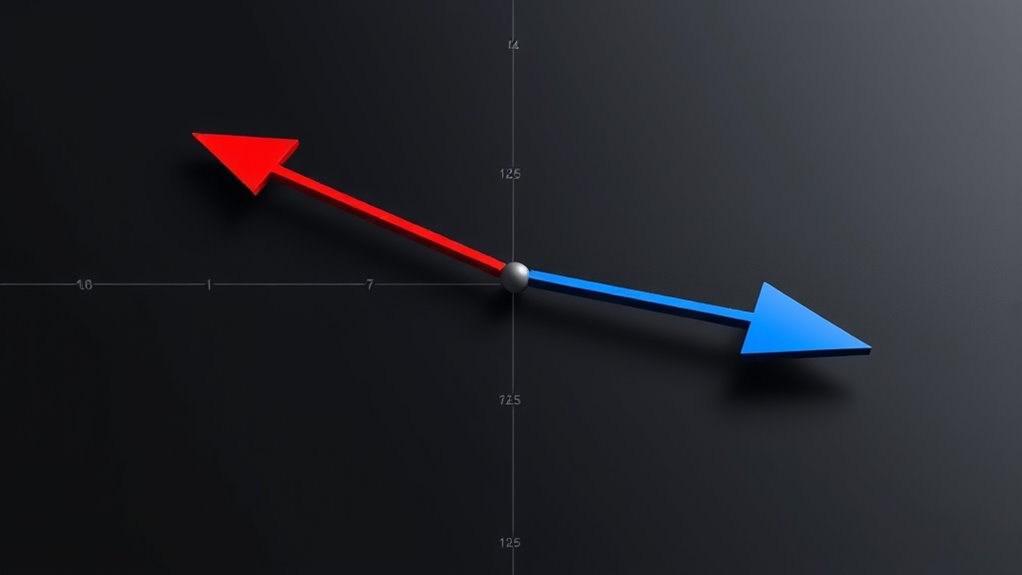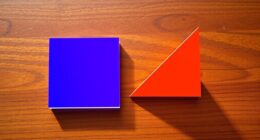To compute the angle between two vectors using the dot product, you first find their dot product and divide it by the product of their magnitudes. Then, apply the inverse cosine to this ratio. This process reveals how much the vectors point in the same direction, with angles near zero indicating close alignment. If you explore further, you’ll uncover more about vector interactions, projections, and their geometric significance.
Key Takeaways
- The angle between two vectors can be found using the dot product formula: ( cos theta = frac{mathbf{A} cdot mathbf{B}}{|mathbf{A}||mathbf{B}|} ).
- Calculating the dot product and the magnitudes of vectors enables the use of inverse cosine to determine the angle.
- Normalizing vectors simplifies angle calculations by converting them into unit vectors before applying the dot product.
- The dot product’s value indicates whether vectors are orthogonal (zero), parallel (positive or negative maximum), or at an angle in between.
- Proper vector analysis, including distinguishing between dot and cross products, ensures accurate computation of angles.
Understanding the Dot Product and Its Formula

The dot product is a fundamental operation in vector mathematics that measures how much two vectors point in the same direction. To compute it, you multiply the vector magnitudes by the cosine of the angle between them. This formula reveals how aligned the vectors are, with a larger dot product indicating they point more similarly. The scalar projection is directly related; it tells you how much of one vector lies along the direction of the other. You find the scalar projection by multiplying the magnitude of the first vector by the cosine of the angle between them, which is equivalent to the dot product divided by the magnitude of the second vector. Understanding this formula helps you analyze vector relationships and their directional components effectively. Additionally, recognizing the importance of vector resolution can further enhance your comprehension of how vectors interact in various applications.
Geometric Interpretation of the Dot Product

Understanding the formula for the dot product allows you to see how it relates to the angles and directions of vectors. Geometrically, the dot product measures how much one vector projects onto another, known as the vector projection. When two vectors are aligned, the dot product reaches its maximum, indicating a small angle between them. Conversely, if they are perpendicular, the dot product is zero. Unlike the cross product, which finds a vector perpendicular to both vectors, the dot product focuses on their directional similarity. This geometric interpretation helps you visualize how the dot product reflects the extent to which vectors point in the same direction, making it a valuable tool for understanding angles and relative orientation in space. Additionally, the dot product can be used to calculate the angle between vectors by applying the inverse cosine function to the normalized dot product value.
How to Calculate the Angle Between Two Vectors

Have you ever wondered how to find the angle between two vectors? To do this, you’ll need their vector magnitudes and the cross product. First, find the magnitudes of both vectors. Then, compute the cross product, which gives a vector perpendicular to both original vectors. The magnitude of this cross product relates to the sine of the angle between them. Using the formula, you can determine the angle by taking the inverse sine (arcsin) of the cross product’s magnitude divided by the product of the two vector magnitudes. This method helps you find the angle directly, especially when the cross product is easier to compute than other methods. Remember, understanding the vector magnitude and cross product is key to calculating the precise angle between two vectors. Understanding the cross product is essential for applying this technique accurately.
The Relationship Between Dot Product and Cosine of the Angle

When you calculate the angle between two vectors using the cross product, you’re working with the sine of that angle. The dot product, however, relates directly to the cosine of the angle. This relationship simplifies many calculations: 1. The dot product equals the product of the vectors’ magnitudes and the cosine of the angle between them. 2. You can find the angle by dividing the dot product by the product of the magnitudes and then using the inverse cosine. 3. Vector projection involves scalar multiplication, where projecting one vector onto another uses the dot product to determine the component’s size relative to the other vector. This emphasizes how the dot product encodes the cosine of the angle, connecting geometric intuition with algebraic computation. Additionally, understanding the vector magnitude is essential for accurate calculations and interpretations.
Examples of Computing Angles Using the Dot Product

Now, you’ll see how to calculate angles between vectors using the dot product. We’ll look at examples like orthogonal vectors, which are at right angles, and vectors pointing in the same direction. These cases help clarify how the dot product relates to the angle between vectors. Understanding space and organization principles can also aid in visualizing the relationships between vectors in a geometric context.
Calculating Angle With Dot Product
To find the angle between two vectors using the dot product, you start by applying the formula that relates the dot product to the cosine of the angle:
[cos theta = frac{mathbf{A} cdot mathbf{B}}{|mathbf{A}| |mathbf{B}|}
]
This allows you to compute the angle directly. Here are key steps:
- Calculate the dot product of the vectors to find their vector projection components.
- Use their magnitudes to normalize the dot product.
- Remember, the cross product can help verify if vectors are orthogonal, but for angles, the dot product is essential.
- Applying these calculations within a data-driven strategy can enhance your understanding of vector relationships.
Example: Orthogonal Vectors
Orthogonal vectors are a special case when using the dot product to find angles. When two vectors are orthogonal, their dot product equals zero, indicating a 90-degree angle. To confirm this, you can compare their vector magnitudes; orthogonal vectors have a zero dot product regardless of their magnitudes. Unlike the vector cross product, which measures perpendicularity through a different calculation, the dot product directly reveals the angle between vectors. If the dot product is zero, the cosine of the angle is zero, confirming the vectors are orthogonal. This property simplifies identifying perpendicular vectors in space, making it easier to analyze geometric relationships and solve problems involving angles between vectors.
Example: Same Direction Vectors
When two vectors point in the same direction, their dot product is positive and can be used to find the angle between them. If the vectors are aligned, the angle is zero degrees. To see this in action:
- Calculate the dot product using scalar multiplication of the vectors’ components.
- Recognize that the dot product equals the product of their magnitudes, since they point the same way.
- Use the formula (cos theta = frac{mathbf{a} cdot mathbf{b}}{|mathbf{a}| |mathbf{b}|}) to find the angle, which will be zero for same direction vectors.
- Understanding the vector properties can help in tuning vehicle components for optimal performance, similar to how precise calculations optimize vehicle tuning parameters.
This process highlights how vector addition and scalar multiplication relate, confirming the vectors’ parallelism and direction. When vectors are scaled versions of each other, their dot product helps verify they point identically.
Applications of Vectors and Dot Product in Real-World Scenarios

Vectors and the dot product have practical applications across many fields, helping us solve real-world problems efficiently. In areas like physics, engineering, and computer graphics, you use vector algebra and dot product properties to analyze forces, motion, and angles. For example, calculating work involves the dot product of force and displacement vectors. A clear understanding of Honda Tuning can also inform how modifications impact vehicle performance in various scenarios. Here’s a quick overview:
| Field | Application |
|---|---|
| Physics | Work and energy calculations |
| Engineering | Structural analysis |
| Computer Graphics | Lighting and shading models |
Visualizing Vectors and Their Angles in Space

You can picture vectors as arrows pointing in specific directions in space, representing quantities like force or velocity. Visualizing how these arrows interact helps you understand the effects of the dot product on their angles and magnitudes. By examining these visualizations, you’ll see how the angles between vectors influence their relationships and calculations. Recognizing the importance of empathy in understanding complex human behaviors can also be visualized as vectors with different directions and magnitudes, illustrating how differing perspectives affect interactions.
Vector Representation in Space
Imagine placing an arrow in three-dimensional space to represent a vector; this arrow has both magnitude and direction. To understand vectors better, consider these key points:
- Vector Components: Break down the vector into its x, y, and z parts, helping you analyze each direction separately.
- Space Geometry: Visualize how vectors relate within space, forming angles and shapes that define their interactions.
- Visualizing in Space: Use coordinate axes to plot vectors, making it easier to see their magnitude, direction, and how they connect with others.
Visualizing Dot Product Effects
Visualizing the effects of the dot product involves understanding how the angle between two vectors influences their interaction. When vectors point in similar directions, their dot product is positive, indicating a strong component along each other’s direction. As the angle increases, the dot product decreases, reaching zero at orthogonality. This visualization helps you see how how vectors project onto each other, and the geometric meaning behind the dot product, enhancing your understanding of spatial relationships. Recognizing the vector projection**** provides a clearer picture of how the dot product measures the extent to which vectors align or diverge in space.
Angles Between Vectors
Understanding the angles between vectors is key to grasping how they relate in space. When visualizing vectors, consider these important aspects:
- The angle determines how closely vectors point in the same or opposite directions.
- Using vector projection, you can find the component of one vector along another, revealing their angular relationship.
- The cross product helps visualize vectors perpendicular to both, emphasizing the spatial orientation and the angle between them.
Common Mistakes to Avoid When Calculating Angles

One common mistake when calculating angles between vectors is misapplying the dot product formula or confusing it with the magnitude of the vectors. Remember, the angle θ is found using the dot product formula: cosθ = (u · v) / (||u|| ||v||), where ||u|| and ||v|| are the vector norms. A frequent error is neglecting to normalize the vectors properly or mixing up the dot product with the cross product, which relates to the sine of the angle. Also, verify you use the correct values for vector norms — these are always positive. Failing to double-check calculations or confusing the cross product with the dot product can lead to incorrect angles. Keep your formulas clear, and verify whether you’re working with the dot or cross product to avoid common pitfalls.
Extending the Concept to Higher Dimensions

The concept of the dot product extends seamlessly from two-dimensional vectors to those in higher dimensions. In hyperdimensional spaces, you can still use the dot product to find angles and similarities. Here’s what you should know: 1. It allows you to compare vectors in complex, multi-dimensional contexts. 2. You can apply vector projection techniques to decompose vectors into components, even in spaces with many dimensions. 3. The same formula for the dot product works, just with more components to contemplate. 4. Understanding how to interpret these calculations can help in analyzing vector relationships across various fields.
Practice Problems for Mastering Vector Angles

To master vector angles, you’ll practice calculating angles using the dot product. You’ll work through examples to build confidence and recognize common mistakes to prevent. These exercises will sharpen your understanding and guarantee you can solve similar problems with ease. Incorporating professional equipment can improve the quality of your practice recordings and help simulate real-world scenarios.
Calculating Angles Using Dot Product
Calculating angles between vectors using the dot product is a foundational skill that helps you understand the relationship between different directions in space. To do this effectively, focus on three key steps:
- Find the vector magnitude for each vector, which measures their length.
- Use the dot product formula to relate the vectors, considering their components within your coordinate systems.
- Rearrange the formula to solve for the angle, applying the inverse cosine function.
- Remember that detecting passive voice can help clarify your writing and ensure your explanations are active and engaging.
This process allows you to determine the precise angle between vectors, whether in 2D or 3D space. Remember, understanding how the vector magnitude influences the calculation is vital for accurate results, especially when working across different coordinate systems.
Practice With Vector Examples
Practicing with real vector examples helps reinforce your understanding of how to find angles between vectors accurately. Start by choosing vectors and performing vector addition to see how they combine. For example, add vectors component-wise to get a new vector, then use the dot product to find the angle between them. Remember, scalar multiplication can change a vector’s length without affecting its direction, which is useful for adjusting vectors before calculating angles. By working through these examples, you’ll see how vector addition influences the relationship between vectors and how scalar multiplication affects their magnitudes. Repeated practice with different combinations will sharpen your skills in applying the dot product formula, making your understanding of vector angles more intuitive and precise. Understanding vector operations is fundamental to mastering the concepts of angles and their calculations.
Common Mistakes to Avoid
Understanding common mistakes when working with vectors and the dot product is essential to mastering how to find angles accurately. One mistake is confusing the vector magnitude with the dot product; remember, the magnitude measures length, not the product of two vectors. Second, neglecting to verify if vectors are correctly normalized can lead to incorrect angle calculations. Third, confusing the cross product with the dot product can cause errors, especially since the cross product relates to area, not angles. To avoid these pitfalls: 1. Always double-check the vector magnitudes before calculating the dot product. 2. Use normalized vectors when calculating angles to simplify the process. 3. Don’t mix up the cross product with the dot product—they serve different purposes in vector analysis. Being mindful of these mistakes ensures precise angle measurements. Additionally, understanding the properties of the dot product helps in avoiding common errors and improves the accuracy of your calculations.
Frequently Asked Questions
How Do Vectors Behave in Non-Euclidean Geometries?
You might wonder how vectors behave in non-Euclidean geometries. In these spaces, geodesic distances replace straight lines, and curvature effects distort traditional vector notions. Vectors still represent directions and magnitudes, but their addition and scalar multiplication adapt to curved surfaces. As a result, angles and distances between vectors are influenced by the geometry’s curvature, causing behaviors that differ from flat Euclidean space, often leading to fascinating geometric and physical insights.
Can Dot Products Be Used to Find Angles in Curved Spaces?
You might wonder if dot products can find angles in curved space, and the answer is yes, but with nuances. In curved space, geodesic angles are measured along shortest paths, not straight lines. While the classic dot product helps in Euclidean geometry, in curved spaces, you use generalized concepts like the metric tensor to determine angles between vectors. So, though the principle is similar, it adapts to the curvature of the space.
How Does the Dot Product Relate to Vector Projections?
When you ask how the dot product relates to vector projection, you’re exploring how one vector can be represented along another. The dot product helps you find the magnitude of this projection by multiplying the vectors and dividing by the length of the original vector. This way, the dot product directly determines how much of one vector lies in the direction of the other, making it essential for calculating vector projections.
Are There Alternative Methods to Find Angles Between Vectors?
This question is a goldmine of possibilities! Besides the dot product, you can find the geometric angle between vectors using the vector cross product, which gives you the area of the parallelogram they span. By calculating the magnitude of the cross product and dividing it by the product of the vectors’ magnitudes, you can determine the sine of the angle. This method provides an alternative way to measure angles between vectors confidently.
How Does Vector Magnitude Affect the Dot Product Calculations?
You might wonder how vector magnitude affects the dot product calculations. The vector length, or magnitude, directly influences the dot product because the result depends on both the magnitudes of the vectors and their angle. The magnitude influence means that larger vectors tend to produce bigger dot products when aligned, while smaller ones produce less. Remember, the dot product combines these magnitudes with the cosine of the angle between them.
Conclusion
Understanding how to compute angles between vectors using the dot product can boost your grasp of geometry and physics. Did you know that in three-dimensional space, the angle calculation method applies just as easily to higher dimensions? Mastering this skill opens doors to fields like computer graphics, robotics, and data analysis. With practice, you’ll find calculating angles becomes second nature—making complex problems much more manageable and even fun!






